Nara Prefecture’s World Heritage Properties
Since Buddhist Monuments in the Horyu-ji Area was one of the first of Japan’s properties to be inscribed on the World Heritage List in 1993, two more Nara Prefecture properties have been inscribed—Historic Monuments of Ancient Nara, and Sacred Sites and Pilgrimage Routes in the Kii Mountain Range.
Now, another—Asuka-Fujiwara: Ancient Capitals of Asuka and Fujiwara—is on the Tentative List for possible inclusion as a World Heritage property.
Here, we give an overview of what World Heritage is, and introduce the above four properties.
What is World Heritage?

World Heritage refers to properties that the United Nations Educational, Scientific and Cultural Organization (UNESCO) selects according to the rules of the World Heritage Convention and that it inscribes on its World Heritage List.
The World Heritage List records examples of cultural or natural heritage that have “outstanding universal value” for all humankind.
World Heritage properties are divided into three categories: cultural heritage (buildings, archaeological sites, cultural landscapes, etc.). natural heritage (natural topography, geological features, ecosystems, natural landscapes, etc.), and mixed heritage, which combines both. In accordance with the World Heritage Convention’s aim of preserving such heritage, these properties that are inscribed on the World Heritage List require conservation and management.
Inscription certificates for the three World Heritage
Sites in Nara Prefecture
-
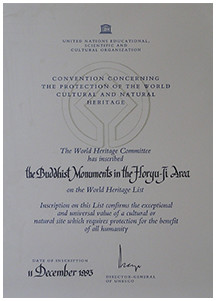
Buddhist Monuments
in the Horyu-ji Area -
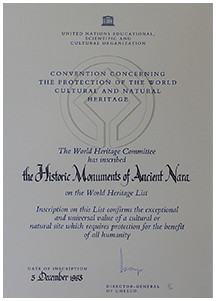
Historic Monuments of
Ancient Nara -
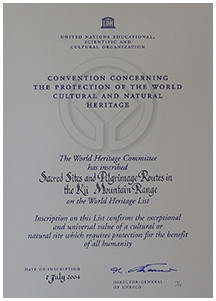
Sacred Sites and
Pilgrimage Routes in the
Kii Mountain Range
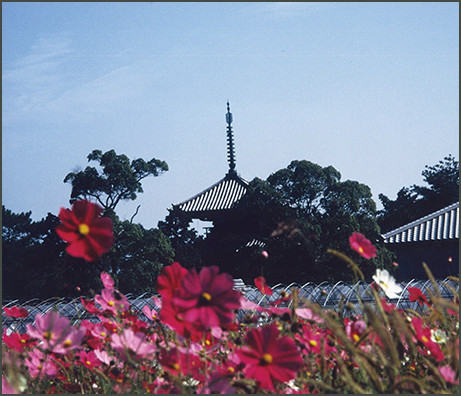
Buddhist Monuments in the Horyu-ji Area
Inscribed 1993 (Cultural Heritage)
Includes wooden structures located at the two sites of Horyu-ji Temple and Hoki-ji Temple. In 1993, alongside Himeji Castle, Buddhist Monuments in the Horyu-ji Area was one of the first Japanese properties to be inscribed on the UNESCO World Heritage List.
Horyu-ji Temple is said to have been constructed by Prince Shotoku in the year 607. The complex comprises two parts: the Sai-in in the west, and the To-in in the east. The Sai-in is home to the Kondo hall, a five-story pagoda, the Chumon inner gate, covered walkways, and other monuments that are the oldest wooden structures still extant in Japan, having been erected during the period from the latter half of the seventh century to the start of the eighth.
Hoki-ji was built in the seventh century, but only the three-story pagoda remains from that time.
The wooden monuments were created in the first years of Buddhism’s arrival in Japan from China, via the Korean Peninsula, and are praised as excellent examples of Buddhist architecture. Surrounded by structures from later eras, it is possible to trace the changes in Japanese Buddhist buildings and the monuments show how a uniquely Japanese architecture style developed.
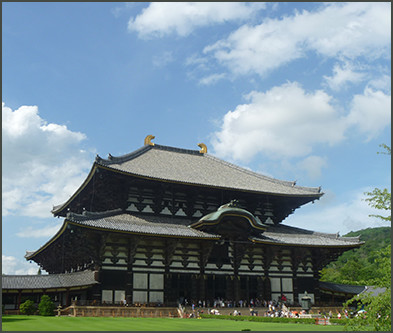
Historic Monuments of Ancient Nara
Inscribed in 1998 (Cultural Heritage)
There are eight properties included in the Historic Monuments of Ancient Nara inscription: Todai-ji Temple, Kohfuku-ji Temple, Kasuga-Taisha Shrine, Kasugayama Primeval Forest, Gango-ji Temple, Yakushi-ji Temple, Toshodai-ji Temple, and the Nara Palace Site.
With the move of the capital to what is now Nara in 710, the Nara period began. The city, known then as Heijo-kyo, was built following the example of Chang’an, a city in Tang-dynasty China, and Japanese culture developed dramatically through ties with China and the Korean peninsula. Politics and culture lay at the heart of Heijo-kyo, and many temples and shrines were erected in the city and the surrounding area. Historic Monuments of Ancient Nara covers the archaeological remains of Heijo-kyo, as well as temple and shrine grounds and religious buildings, and the Shinto cultural landscapes of Kasuga-taisha Shrine and Kasugayama Primeval Forest. It relays religion and way of life in the incredibly important Nara period of the eighth century, which led to political and cultural changes in Japan. It has also been highly praised for the way in which that tradition lives on in people’s lives even now.
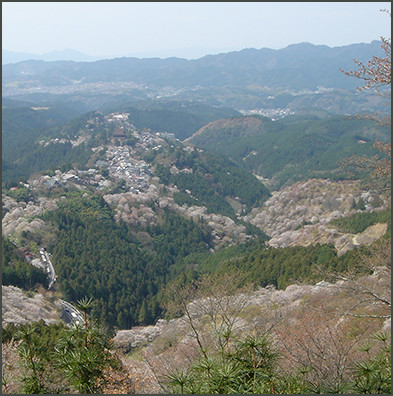
Sacred Sites and Pilgrimage Routes in the Kii Mountain Range
Inascribed in 2004 (Cultural Heritage)
Sacred Sites and Pilgrimage Routes in the Kii Mountain Range stretches over Nara, Mie, and Wakayama prefectures, and includes three sacred sites—Yoshino and Omine, Kumano Sanzan, and Koyasan—and the pilgrimage routes—Omine Okugakemichi, Kumano Sankeimichi, and Koyasan Sankeimichi—that connect them. Of these, the Yoshino and Omine site and the Omine Okugakemichi and the Kohechi route of the Kumano Sankeimichi can be found in Nara Prefecture.
The Kii Mountain Range is a mountain belt formed of deep forests and steep-sloped mountains that stretch out in every direction, and is characterized by its topography near the sea at its southern edge. It is a landscape rich in nature, where the beliefs of nature worship, present in Japan since time immemorial, fused with Buddhist teachings from the Asian continent, giving birth to myriad forms of religious belief.
The sacred site of Yoshino and Omine, located in the northernmost part of the Kii Mountain Range, includes Mount Yoshino, Yoshinomikumari-jinja Shrine, Kimpu-jinja Shrine, Kimpusen-ji Temple, Yoshimizu-jinja Shrine, and Ominesan-ji Temple. The area, with rows of mountains between one and two thousand meters tall, is sacred to the Shugendo mountain ascetic sect. In the mid-tenth century it became Japan’s foremost sacred site, and belief blossomed.
The cultural landscape of the Sacred Sites and Pilgrimage Routes in the Kii Mountain Range area is one that combines these properties with scenery born out of nature and human activity. It is particularly impressive for the way that these traditions have been passed down from ancient history to the present day.
Properties in Nara added to the
World Heritage Tentative List
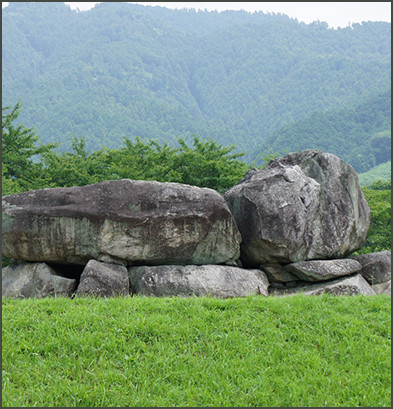
Asuka-Fujiwara: Ancient Capitals of Asuka and Fujiwara
Added in 2007 (Tentative List)
Asuka-Fujiwara: Ancient Capitals of Asuka and Fujiwara refers to a number of sites, constructed between the end of the sixth century and the start of the eighth, that show what the ancient capitals of Japan once look liked. Sites include remains of the Asuka and Fujiwara palaces, as well as palace-related sites (Asuka Capital’s Garden Pond Site, Yamato Sanzan, etc.), remains of Buddhist temples (Asuka-dera Temple, Yamada-dera Temple, Motoyakushi-ji Temple, etc.), and burial mounds (Ishibutai Tomb, Takamatsuzuka Tomb, Kitora Tomb, etc.).
During the period, lively interaction with China and the Korean peninsula led to the development of uniquely Japanese forms of political system, technology, and religion, and Japanese culture took shape.
Happily, in Asuka and Fujiwara, archaeological sites from that era remain, and tell us much about the form the capitals took. With an appeal based on these points, the aim is for this property to be inscribed as a full-fledged World Heritage Property.
Related pages on the Ikasu-Nara website
-
- In-depth Investigation! Historical and Cultural Resources: Changes in Buddhism in Nara Prefecture
-
http://www.pref.nara.jp/miryoku/ikasu-nara/fukabori/detail01/
-
- Putting Nara in Perspective
-
- Historical Archives
